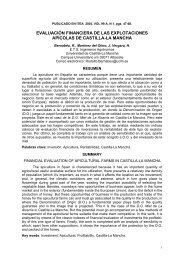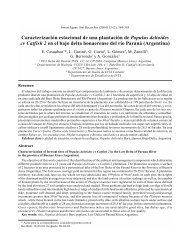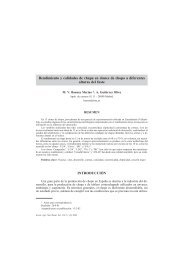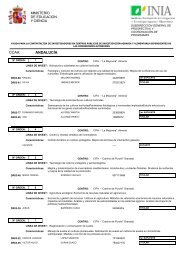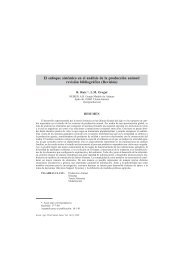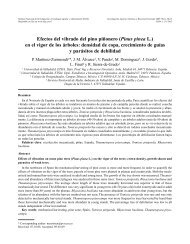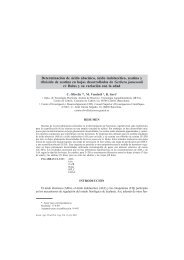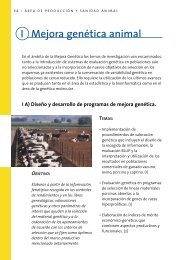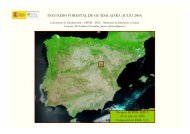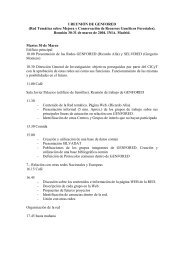Status of medicinal and aromatic plants in - Inia
Status of medicinal and aromatic plants in - Inia
Status of medicinal and aromatic plants in - Inia
Create successful ePaper yourself
Turn your PDF publications into a flip-book with our unique Google optimized e-Paper software.
PRESENTED PAPERS 131<br />
makes Serbia a country with very high floristic diversity <strong>and</strong> density per unit area compared<br />
to other European countries. All plant species are <strong>in</strong>cluded <strong>in</strong> 141 families <strong>and</strong> 766 genera.<br />
In addition to its position <strong>in</strong> the Balkans, Serbia also occupies the southeastern part <strong>of</strong> the<br />
Pannonian pla<strong>in</strong> <strong>in</strong> the Vojvod<strong>in</strong>a region. It is thus divided <strong>in</strong>to two dist<strong>in</strong>ct geographical<br />
<strong>and</strong> orographic entities which are, though separated by the rivers Sava <strong>and</strong> Danube,<br />
<strong>in</strong>terconnected by lowl<strong>and</strong> hilly peripannonian Serbia. These basic geographical <strong>and</strong><br />
l<strong>and</strong>scape entities have determ<strong>in</strong>ed the characteristics <strong>of</strong> the Serbian flora <strong>and</strong> vegetation, as<br />
well as the differences between the <strong>plants</strong> distributed <strong>in</strong> these two micro-regions <strong>of</strong> Serbia.<br />
Montenegro covers a territory <strong>of</strong> 13 812 km 2 . A total <strong>of</strong> 3136 plant taxa (2920 species with<br />
216 subspecies) have been recorded (Stevanović et al. 1995) belong<strong>in</strong>g to 804 genera <strong>and</strong><br />
151 families. The floristic richness <strong>of</strong> Montenegro can be expla<strong>in</strong>ed by various causes,<br />
<strong>in</strong>clud<strong>in</strong>g geography (presence <strong>of</strong> coasts <strong>and</strong> mounta<strong>in</strong>s), historical <strong>and</strong> other factors.<br />
Accord<strong>in</strong>g to the total plant species number per territory size (LogS/LogA), Yugoslavia<br />
ranks fifth among European countries, Serbia eighth <strong>and</strong> Montenegro first.<br />
Consider<strong>in</strong>g the vegetation diversity <strong>of</strong> Yugoslavia, over 600 <strong>in</strong>dividual plant<br />
communities have been identified, <strong>in</strong>clud<strong>in</strong>g forests (deciduous <strong>and</strong> coniferous), steppes,<br />
Mediterranean vegetation, meadows, pastures, vegetation <strong>of</strong> s<strong>and</strong> dunes <strong>and</strong> sal<strong>in</strong>e soils,<br />
swamps, alp<strong>in</strong>e tundra, etc.<br />
MAP diversity is also quite high. More than 700 species are considered as <strong>medic<strong>in</strong>al</strong><br />
(Sarić 1989), which accounts for 17.29% <strong>of</strong> the total flora. Among those, 420 plant species are<br />
<strong>of</strong>ficially registered (10.75% <strong>of</strong> the total flora), while 279 are to be found <strong>in</strong> Serbian markets.<br />
Medic<strong>in</strong>al <strong>plants</strong> <strong>of</strong> Yugoslavia encompass 89 families, <strong>of</strong> which the follow<strong>in</strong>g should be<br />
quoted: Lamiaceae (41 species), Asteraceae (40), Apiaceae (20), Ranunculaceae (19),<br />
Scrophulariaceae (17), Malvaceae (15), Rosaceae (15), Brassicaceae (10), Polygonaceae (10),<br />
etc.<br />
Significance <strong>of</strong> natural resources<br />
Meadows <strong>and</strong> forests are the ma<strong>in</strong> resources <strong>of</strong> <strong>in</strong>digenous <strong>medic<strong>in</strong>al</strong> <strong>and</strong> <strong>aromatic</strong> <strong>plants</strong>.<br />
A recent analysis <strong>of</strong> MAP distribution <strong>in</strong> Serbian forests (Obratov et al. 2002) showed that<br />
<strong>in</strong> oak communities (ass. Quercetum fra<strong>in</strong>etto-cerris, the most common forest community <strong>of</strong><br />
Serbia), a total <strong>of</strong> 123 plant species have been identified, <strong>in</strong>clud<strong>in</strong>g 53 <strong>medic<strong>in</strong>al</strong> <strong>plants</strong>. Some<br />
<strong>of</strong> the most important <strong>medic<strong>in</strong>al</strong> <strong>plants</strong> <strong>in</strong> oak forests are the follow<strong>in</strong>g: Achillea millefolium,<br />
Acer tataricum, Ajuga reptans, Campanula glomerata, Crataegus monogyna, Cornus sangu<strong>in</strong>ea,<br />
Euphorbia cyparissias, Filipendula hexapetalla, Sorbus aucuparia, etc.<br />
At higher altitudes, above the oak zone, beech forests (ass. Fagetum montanum) are well<br />
developed. This association is present on two parent rocks: limestone <strong>and</strong> silicate. Different<br />
plant species are found on different types <strong>of</strong> parent rock. On limestone 45 <strong>medic<strong>in</strong>al</strong> <strong>plants</strong><br />
were identified, <strong>of</strong> which 4 are recommended for exploitation: Veronica <strong>of</strong>fic<strong>in</strong>alis, Tamus<br />
communis, Clematis vitalba <strong>and</strong> Corylus avellana. On silicate parent rock 15 different <strong>medic<strong>in</strong>al</strong><br />
<strong>plants</strong> were identified, <strong>of</strong> which two are <strong>of</strong> greater significance: Calam<strong>in</strong>tha <strong>of</strong>fic<strong>in</strong>alis <strong>and</strong><br />
Asarum europaeum.<br />
The approximate total number <strong>of</strong> <strong>medic<strong>in</strong>al</strong> plant species present <strong>in</strong> Serbia is 400, with 122<br />
<strong>medic<strong>in</strong>al</strong> <strong>plants</strong> <strong>in</strong> beech forests (about 30%).<br />
Meadows <strong>and</strong> pastures <strong>of</strong> Serbia have not been sufficiently utilized, although they have<br />
great potential for cattle breed<strong>in</strong>g. The total area covered by grassl<strong>and</strong>s <strong>in</strong> Serbia is about<br />
1.65 million ha. They are widespread <strong>in</strong> very diverse ecological conditions, occurr<strong>in</strong>g at<br />
different altitudes <strong>and</strong> on various forms <strong>of</strong> relief, soil type, climate, etc. Therefore, meadow<br />
vegetation comprises many plant communities differ<strong>in</strong>g <strong>in</strong> floristic structure, stability <strong>and</strong><br />
type <strong>of</strong> succession. Besides agriculture, they may serve as a ma<strong>in</strong> source for <strong>medic<strong>in</strong>al</strong> plant<br />
exploitation <strong>and</strong> as a natural genebank <strong>of</strong> various populations suitable for further cultivation<br />
<strong>and</strong> selection.




